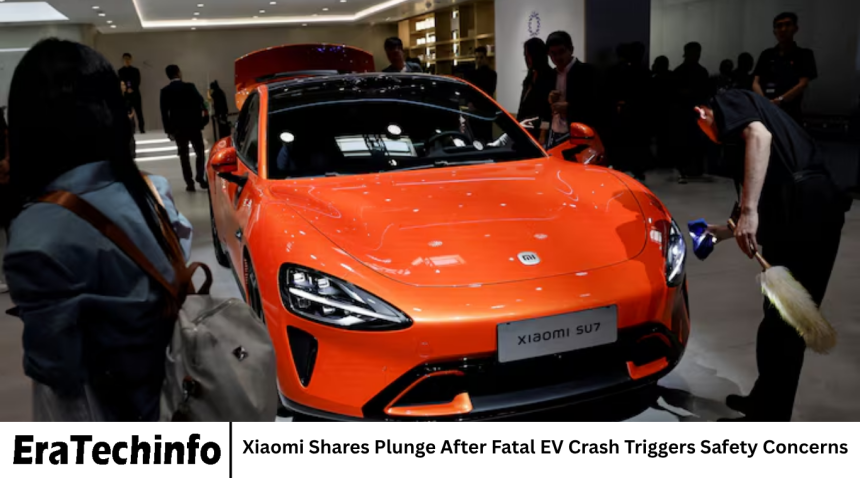Xiaomi, one of China’s most prominent technology companies, has been making major strides into the electric vehicle (EV) market. However, its ambitious journey took a serious hit when news broke of a fatal crash involving one of its electric cars. The incident sparked widespread concern about the safety of Xiaomi’s vehicles and led to a sharp decline in the company’s share price—the biggest drop since April.
- The Incident That Shook Investor Confidence
- Xiaomi’s Entry into the Electric Vehicle Market
- Safety Features Under Scrutiny
- Public and Regulatory Response
- The Impact on Xiaomi’s Share Price
- The Role of Technology and Software
- Comparing Xiaomi’s Case to Other EV Crashes
- Investor Sentiment and Market Outlook
- The Broader Challenge for the EV Industry
- Xiaomi’s Response and Next Steps
- The Future of Xiaomi’s EV Ambitions
- Frequently Asked Questions
- Conclusion
For a company that built its reputation on innovation and reliability in smartphones and smart devices, the crash has raised difficult questions. How safe are Xiaomi’s EVs? What went wrong? And what does this mean for the company’s future in an increasingly competitive electric vehicle industry?
This article takes a deep look into the incident, its causes, the reaction from investors and regulators, and the potential long-term implications for Xiaomi’s growing EV empire.
The Incident That Shook Investor Confidence
According to reports, the fatal accident occurred when a Xiaomi electric vehicle lost control and crashed at high speed. The details are still emerging, but early indications suggest the vehicle may have been operating with its advanced driver-assistance system (ADAS) engaged—a feature Xiaomi has heavily promoted as part of its intelligent driving technology.
The crash resulted in the death of at least one person and left others injured. Local authorities have launched an investigation to determine whether human error, mechanical failure, or software malfunction was to blame.
As soon as the news became public, Xiaomi’s shares dropped sharply, falling more than 7% in a single trading session—the company’s steepest decline since April. The selloff reflected growing investor fears that safety issues could derail Xiaomi’s entry into the EV market.
Xiaomi’s Entry into the Electric Vehicle Market
Xiaomi officially announced its EV venture in 2021, investing billions of dollars to compete with established automakers like Tesla, BYD, and NIO. The company’s first electric vehicle, the Xiaomi SU7, launched with high expectations earlier this year.
The SU7 was praised for its sleek design, advanced features, and integration with Xiaomi’s broader ecosystem of smart devices. Xiaomi positioned its EVs as affordable, high-tech alternatives for consumers seeking performance and innovation.
The company’s founder and CEO, Lei Jun, described EVs as the next major chapter in Xiaomi’s evolution—from a smartphone brand to a comprehensive smart technology provider. However, the fatal crash has cast a shadow over this vision, threatening to slow down what was once seen as a promising start.
Safety Features Under Scrutiny
The Xiaomi SU7 boasts a suite of advanced driver-assistance systems designed to improve safety and comfort. These include lane-keeping assistance, adaptive cruise control, automatic emergency braking, and semi-autonomous driving capabilities.
After the accident, experts began to question whether these systems performed as intended. Did the car fail to detect obstacles? Was the system properly calibrated? Or was it a case of driver overreliance on automation?
While Xiaomi has not yet confirmed the exact cause, it has stated that it is fully cooperating with the investigation. The company has also promised to conduct an internal review of its driving-assistance software and safety mechanisms.
Public and Regulatory Response
Public reaction in China was swift and divided. While some defended Xiaomi, arguing that any new automaker faces early challenges, others accused the company of rushing its vehicles to market without sufficient testing.
Social media users flooded online platforms with debates over EV safety, with many drawing comparisons to Tesla’s history of crashes linked to its Autopilot system. Several EV enthusiasts expressed concern that advanced driving technologies may give drivers a false sense of security, leading them to become overly dependent on automation.
Regulators have taken notice too. China’s Ministry of Industry and Information Technology (MIIT) and local traffic safety bureaus have reportedly begun gathering information from Xiaomi about the incident. If regulators find safety violations or defects, the company could face penalties or even recalls.
The Impact on Xiaomi’s Share Price
The stock market reaction to the crash was immediate and severe. Xiaomi’s shares tumbled as investors worried about potential lawsuits, recalls, or damage to the company’s brand reputation.
Analysts noted that the selloff reflected not just fear of short-term losses but also doubts about Xiaomi’s long-term ability to compete in the EV market. Entering the automotive industry is an enormous challenge, especially in China, where competition is intense and margins are thin.
While some investors believe the stock will recover once the company demonstrates transparency and accountability, others see this as a warning sign that Xiaomi’s diversification strategy carries serious risks.
The Role of Technology and Software
One of Xiaomi’s main selling points has been its use of cutting-edge technology. Its vehicles rely heavily on software integration, artificial intelligence, and smart sensors to deliver a connected and efficient driving experience.
However, this reliance on software also introduces new challenges. Even small coding errors or sensor failures can have catastrophic consequences in a vehicle traveling at high speed.
The EV industry as a whole is grappling with this issue. Automakers are racing to develop autonomous systems that are reliable and safe under all conditions. Yet, as the Xiaomi crash shows, even the most advanced systems are not immune to flaws or misuse.
Experts argue that while driver-assistance features can enhance safety, they are not substitutes for human vigilance. Drivers must understand the limitations of these systems and remain alert at all times.
Comparing Xiaomi’s Case to Other EV Crashes
Xiaomi is not the first automaker to face scrutiny over an EV-related crash. Tesla, NIO, and XPeng have all dealt with accidents involving vehicles equipped with semi-autonomous features. In many cases, investigations revealed that drivers misunderstood how the technology worked or failed to take control when necessary.
These incidents have prompted global regulators to tighten rules on driver-assistance systems. Automakers are now required to include clearer warnings, stricter monitoring systems, and improved fail-safes to prevent accidents.
The Xiaomi crash could accelerate similar changes in China’s regulatory environment. Authorities may impose new safety standards or require additional testing before allowing such features to be marketed to consumers.
Investor Sentiment and Market Outlook
Despite the negative headlines, some analysts see this as a temporary setback for Xiaomi rather than a permanent blow. The company has a strong financial foundation, a loyal customer base, and a proven track record in innovation.
However, recovering from a fatal accident will require careful crisis management. Xiaomi must act quickly to restore public confidence by addressing safety concerns, being transparent with findings, and demonstrating its commitment to user protection.
If handled well, the incident could ultimately strengthen Xiaomi’s operations by forcing the company to improve safety and quality control. But if mismanaged, it could damage the brand’s credibility and slow down its EV ambitions.
The Broader Challenge for the EV Industry
The incident highlights a broader challenge facing the entire EV sector—balancing innovation with safety. As companies compete to introduce more advanced features, they face pressure to move fast. But speed can sometimes come at the cost of thorough testing.
Modern vehicles are increasingly defined by software rather than hardware. That means automakers must act not only as engineers but also as technology developers, ensuring that every line of code is tested for reliability.
Consumers are also learning that “self-driving” does not mean “driver-free.” Greater public education about how these systems work is essential to prevent overreliance and misuse.
Xiaomi’s Response and Next Steps
In the days following the crash, Xiaomi issued a public statement expressing condolences to the victims and their families. The company said it was “deeply saddened” by the incident and fully cooperating with authorities.
Xiaomi also confirmed that it had launched an internal investigation into the vehicle’s software, hardware, and operational data. The company pledged to make its findings public and to strengthen its safety protocols if any flaws are discovered.
Analysts believe that Xiaomi’s response will determine how quickly it can regain public and investor trust. Transparency, accountability, and a proactive approach to safety will be key.
The Future of Xiaomi’s EV Ambitions
Before the crash, Xiaomi’s EV division was one of the most exciting stories in China’s tech sector. The company had positioned itself as a challenger to Tesla and other established players, using its expertise in consumer electronics to create a smart mobility experience.
Now, the company faces a crossroads. It must reassure customers that its vehicles are safe while continuing to innovate in a highly competitive market. Xiaomi’s long-term success in the EV space will depend on its ability to balance speed with safety, ambition with responsibility.
If the company learns from this setback and strengthens its safety measures, it could emerge stronger and more trusted. But if similar incidents occur, Xiaomi’s dream of becoming a major EV player could quickly fade.
Frequently Asked Questions
What caused the Xiaomi EV crash?
The exact cause is still under investigation, but initial reports suggest the vehicle may have been using its driver-assistance system at the time of the crash.
How did investors react to the crash?
Xiaomi’s stock price fell more than 7%, marking its biggest single-day drop since April, as investors feared regulatory action and damage to the company’s reputation.
What has Xiaomi said about the incident?
Xiaomi has expressed condolences to the victims and pledged full cooperation with authorities, along with an internal review of its vehicle’s safety systems.
Will this affect Xiaomi’s EV plans?
The crash may slow Xiaomi’s EV rollout temporarily, but if the company responds transparently and strengthens safety standards, it can recover in the long term.
Are Xiaomi’s EVs fully self-driving?
No. Xiaomi’s vehicles include advanced driver-assistance features but still require drivers to remain alert and in control at all times.
How does this compare to other EV accidents?
Similar accidents have involved vehicles from Tesla and NIO, showing that semi-autonomous systems across the industry still face safety and reliability challenges.
What lessons can the EV industry learn from this incident?
Automakers must prioritize testing, transparency, and public education about automation limits to prevent overreliance and ensure driver safety.
Conclusion
The fatal crash involving a Xiaomi electric vehicle has sent shockwaves through the automotive and investment communities. The tragedy not only cost lives but also triggered a serious crisis of confidence in one of China’s most promising new EV brands.
As investigations continue, Xiaomi faces the difficult task of proving that safety—not just technology—is at the heart of its vision for the future. The company’s response in the coming weeks will determine whether this moment becomes a temporary stumble or a lasting setback.
The incident is also a reminder for the entire EV industry that innovation must go hand in hand with responsibility. In the race to electrify and automate transportation, ensuring human safety remains the most important goal of all.










